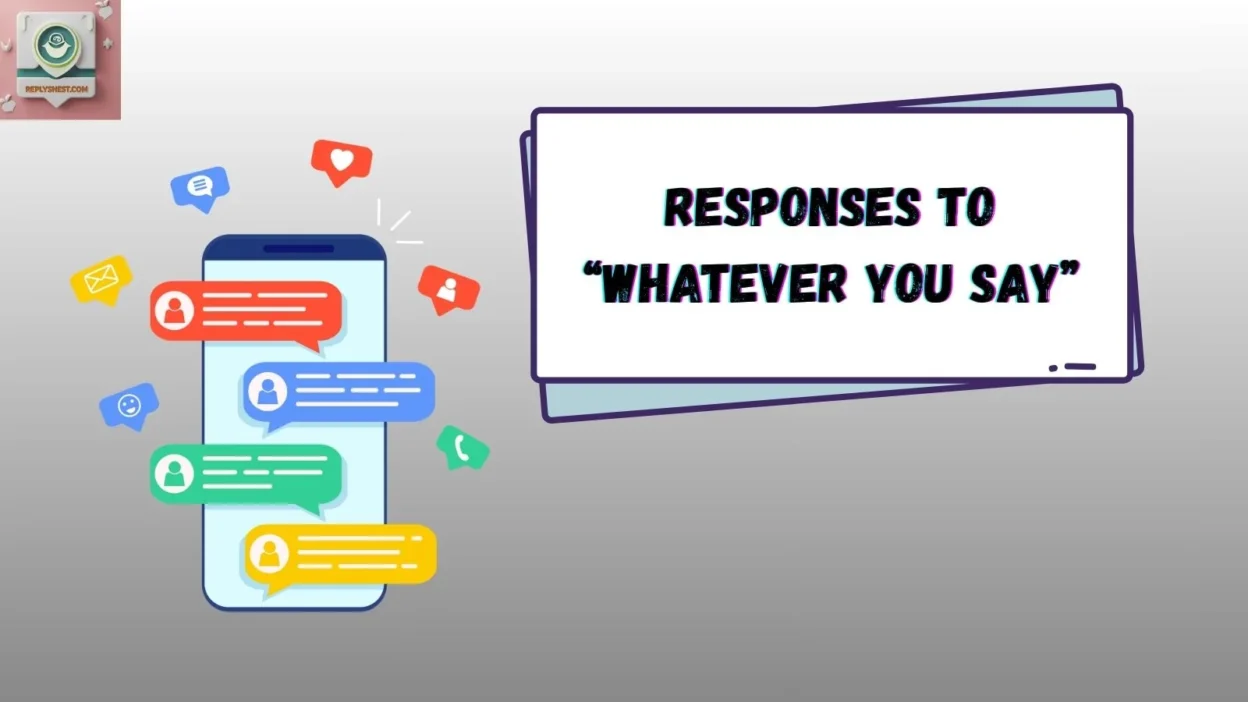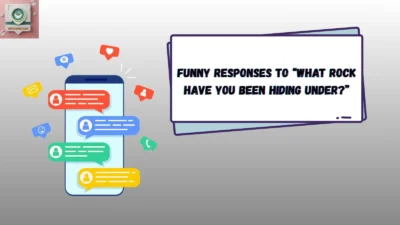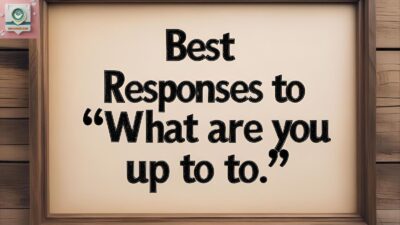When someone replies with “whatever you say,” it can feel a bit dismissive or even sarcastic, depending on their tone and the context. In many conversations, I’ve noticed that people use this phrase either to avoid escalating a conflict or to subtly signal disagreement without sounding confrontational. A good response should stay calm, polite, and neutral, helping the conversation flow smoothly rather than turn cold or defensive. Responses to “Whatever You Say”.
You can acknowledge the person’s feelings, show empathy, and use your communication skills to de-escalate the situation. For example, saying something like, “I appreciate your perspective, but can we talk about it further?” keeps the dialogue open and shows you’re listening without letting the topic feel closed.
From my own experience, responding wisely to “whatever you say” requires awareness of your relationship with the person—whether it’s a friend, a coworker, or a romantic partner. A playful or lighthearted reply, such as “That’s one way to agree,” can bring humor and positivity back into the exchange, especially if the mood feels tense.
If the comment seems more hurtful or cold, a more assertive yet compassionate approach like, “I hear you, but I’d like to understand what you mean exactly,” can invite clarity and mutual understanding. This type of communication shows maturity, respect, and a genuine interest in keeping the conversation balanced, constructive, and full of emotional intelligence.
1. “Fair enough.”
A gentle acknowledgment that you’ve heard them, without inviting conflict.
Best Use: When you want to stay calm and neutral during mild disagreement.
Not to Use: When sarcasm is obvious — it might sound passive-aggressive.
Other Ways to Say: “Alright, I get your point.” / “That’s reasonable.”
Example:
A: “Whatever you say.”
B: “Fair enough — let’s just move on from this one.”
2. “You might be right.”
This shows maturity and respect for the other person’s opinion.
Best Use: When you want to de-escalate and show openness.
Not to Use: When you strongly disagree but don’t plan to discuss it.
Other Ways to Say: “You could be right about that.” / “That’s possible.”
Example:
A: “Whatever you say.”
B: “You might be right — I’ll think about it.”
3. “I see where you’re coming from.”
Adds empathy and calm understanding to the conversation.
Best Use: When someone feels unheard or defensive.
Not to Use: If you don’t genuinely understand their view — it can sound fake.
Other Ways to Say: “I get your perspective.” / “I understand your point.”
Example:
A: “Whatever you say.”
B: “I see where you’re coming from — let’s revisit this later.”
4. “Let’s agree to disagree.”
A respectful full stop that keeps relationships intact.
Best Use: When neither side will budge.
Not to Use: When the issue needs a real resolution.
Other Ways to Say: “We may see this differently, and that’s okay.”
Example:
A: “Whatever you say.”
B: “Let’s agree to disagree — no hard feelings.”
5. “I didn’t mean to sound bossy.”
Softens your tone if the other person felt overruled.
Best Use: When you realize you came across too assertively.
Not to Use: When you actually were joking or casual — it may seem over-apologetic.
Other Ways to Say: “Sorry if I sounded pushy.”
Example:
A: “Whatever you say.”
B: “Oops, didn’t mean to sound bossy — just trying to help.”
6. “Hey, I wasn’t trying to upset you.”
Shows care and emotional awareness.
Best Use: When tension rises unexpectedly.
Not to Use: If they’re clearly joking.
Other Ways to Say: “Didn’t mean to offend you.” / “I’m just sharing my view.”
Example:
A: “Whatever you say.”
B: “Hey, I wasn’t trying to upset you — just explaining my side.”
7. “Haha, touché!”
Adds light humor to show you’re not taking things too seriously.
Best Use: When the tone is playful or teasing.
Not to Use: During serious conversations.
Other Ways to Say: “You got me there!”
Example:
A: “Whatever you say.”
B: “Haha, touché — I’ll take that one.”
8. “We both have strong opinions — that’s okay.”
Balances assertiveness with maturity.
Best Use: When the discussion gets heated.
Not to Use: If they’re uninterested in resolution.
Other Ways to Say: “It’s good we both care enough to discuss it.”
Example:
A: “Whatever you say.”
B: “We both have strong opinions — that’s okay, it means we care.”
9. “You sound frustrated — want to talk about it?”
Shows emotional intelligence and empathy.
Best Use: When you sense hidden irritation.
Not to Use: If they clearly want to end the talk.
Other Ways to Say: “Seems like something’s bothering you.”
Example:
A: “Whatever you say.”
B: “You sound frustrated — what’s going on?”
10. “Let’s not turn this into an argument.”
A gentle reminder to preserve peace.
Best Use: When conversation starts spiraling.
Not to Use: If they’re not angry — might sound defensive.
Other Ways to Say: “Let’s not make this a big deal.”
Example:
A: “Whatever you say.”
B: “Let’s not turn this into an argument — we’re good.”
11. “I respect that.”
Short, simple, and classy.
Best Use: When you want to end respectfully.
Not to Use: If they’re being rude or sarcastic.
Other Ways to Say: “I hear you.” / “That’s fair.”
Example:
A: “Whatever you say.”
B: “I respect that — thanks for sharing.”
12. “We don’t have to agree on everything.”
Shows maturity and understanding.
Best Use: In healthy debates or relationships.
Not to Use: If agreement is essential (like teamwork).
Other Ways to Say: “Differences make us interesting.”
Example:
A: “Whatever you say.”
B: “We don’t have to agree on everything — that’s what keeps it real.”
13. “Alright, let’s just move forward.”
Keeps things productive.
Best Use: In work or decision-making discussions.
Not to Use: If the other person feels deeply hurt.
Other Ways to Say: “Let’s move on.”
Example:
A: “Whatever you say.”
B: “Alright, let’s just move forward with this plan.”
14. “Noted.”
Professional and neutral.
Best Use: In business settings or formal chats.
Not to Use: In personal relationships — can sound cold.
Other Ways to Say: “Understood.” / “Got it.”
Example:
A: “Whatever you say.”
B: “Noted. Let’s check back tomorrow.”
15. “I get that you’re not in the mood to talk.”
Acknowledges their emotion rather than reacting.
Best Use: When they sound dismissive out of irritation.
Not to Use: When it’s clearly a joke.
Other Ways to Say: “You seem off — want some space?”
Example:
A: “Whatever you say.”
B: “I get that you’re not in the mood to talk — let’s chat later.”
16. “You seem done with this topic — let’s pause.”
Keeps boundaries and respect intact.
Best Use: In emotionally heavy discussions.
Not to Use: During fun or light talks.
Other Ways to Say: “We can revisit later.”
Example:
A: “Whatever you say.”
B: “You seem done with this topic — let’s pause for now.”
17. “I’ll take that as agreement!”
Adds a playful twist.
Best Use: In friendly banter.
Not to Use: When they’re clearly annoyed.
Other Ways to Say: “So, we’re on the same page then?”
Example:
A: “Whatever you say.”
B: “I’ll take that as agreement, then!”
18. “Let’s focus on finding a solution.”
Redirects to action instead of emotion.
Best Use: In problem-solving or work settings.
Not to Use: If they just need to vent.
Other Ways to Say: “Let’s work on a fix.”
Example:
A: “Whatever you say.”
B: “Let’s focus on finding a solution — not just the issue.”
19. “We both care, just in different ways.”
Adds emotional depth and reassurance.
Best Use: When a disagreement stems from good intentions.
Not to Use: If they’re dismissive without reason.
Other Ways to Say: “We’re on the same team, just different approaches.”
Example:
A: “Whatever you say.”
B: “We both care, just in different ways — that’s okay.”
20. “That’s one way to look at it.”
Shows tolerance for multiple viewpoints.
Best Use: In discussions with differing opinions.
Not to Use: If you’re expected to agree.
Other Ways to Say: “Interesting perspective.”
Example:
A: “Whatever you say.”
B: “That’s one way to look at it — I see what you mean.”
21. “Let’s just agree we both mean well.”
Adds compassion and closure.
Best Use: In personal relationships.
Not to Use: When deeper issues are unresolved.
Other Ways to Say: “We’re both trying our best.”
Example:
A: “Whatever you say.”
B: “Let’s just agree we both mean well.”
22. “Haha, okay boss!”
Playfully acknowledges without tension.
Best Use: Among friends or light moments.
Not to Use: In serious or professional talks.
Other Ways to Say: “Yes, captain!” / “You got it!”
Example:
A: “Whatever you say.”
B: “Haha, okay boss — I’ll roll with it.”
23. “No worries, we’ll figure it out.”
Shows optimism and calm.
Best Use: In problem-solving or misunderstandings.
Not to Use: When someone needs a direct apology.
Other Ways to Say: “We’ll sort it out.”
Example:
A: “Whatever you say.”
B: “No worries, we’ll figure it out soon.”
24. “I value your honesty.”
Turns defensiveness into appreciation.
Best Use: When someone speaks bluntly.
Not to Use: If they’re clearly being sarcastic.
Other Ways to Say: “Thanks for being real.”
Example:
A: “Whatever you say.”
B: “I value your honesty — that’s refreshing.”
25. “Let’s leave it there for now.”
Gracefully closes a tough conversation.
Best Use: When discussion becomes unproductive.
Not to Use: If resolution is still needed.
Other Ways to Say: “We’ll revisit this later.”
Example:
A: “Whatever you say.”
B: “Let’s leave it there for now — we’ll talk later.”
Conclusion
Responding to “Whatever you say” doesn’t have to be awkward or defensive. With empathy, humor, or calm acknowledgment, you can turn dismissive moments into meaningful communication.
From “Fair enough” to “Let’s leave it there for now,” each phrase above helps you keep composure while expressing emotional intelligence — the secret to better relationships at work, home, or anywhere conversation happens.
Editor’s Picks: Top 10 Responses to “Whatever You Say”
- “You might be right.” — Perfect for keeping calm and open-minded.
- “Fair enough.” — A neutral tone that ends things gracefully.
- “Haha, touché!” — Ideal for humor in friendly exchanges.
- “Let’s agree to disagree.” — Mature and emotionally balanced.
- “We both have strong opinions — that’s okay.” — Acknowledges passion without hostility.
- “I see where you’re coming from.” — Empathy in action.
- “Let’s focus on finding a solution.” — Productive and emotionally intelligent.
- “I respect that.” — Short, sincere, and graceful.
- “No worries, we’ll figure it out.” — Keeps positivity flowing.
- “Let’s just agree we both mean well.” — Ends with heart and understanding.



